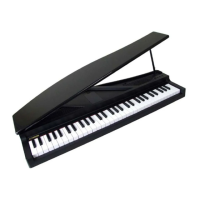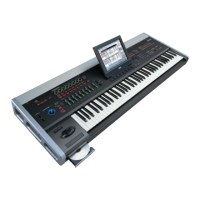Parameter guide
34
PROG P3: Filter
Here you can make the basic settings for RADIAS
oscillator’s Filter A and Filter B. Here you can:
• Specify the filter routing, select the filter type, and set
the cutoff frequency and resonance.
• Specify filter modulation by keyboard tracking, velocity,
and EG1.
3–1: Filter
3–1a: Filter Routing
Filter Routing [Single, Serial, Parallel, Individual]
RADIAS oscillator has two filters, Filter A and Filter B. This
parameter controls whether one or both of the filters are
used, and if both are used, it controls how they are
connected to each other.
Single: Only filter A is used.
Serial. This uses both Filter A and Filter B. The oscillator
first goes through Filter A, and then the output of Filter A is
processed through Filter B.
Parallel. This also uses both Filter A and Filter B. The
oscillator feeds both filters directly, and the outputs of the
two filters are then summed together.
Individual: Filter A and filter B will be used. The oscillator 1
output is sent to filter A, the oscillator 2 and noise output is
sent to filter B, and the outputs of both filters are summed.
3–1b: Filter A
Type/Balance (Filter Type/Balance)
[LPF24…LPF12…HPF…BPF…THRU]
Selects the filter type for filter A. The effect that you obtain
will depend on the filter type. Intermediate values other
than LPF24, LPF12, HPF, BPF, and THRU will provide a
response that is interpolated between the two filters.
LPF12 (–12dB/oct), LPF24 (–24dB/oct): LPF (Low Pass Filter)
is the most common type of filter; it passes the frequencies
below the cutoff frequency and cuts the region above.
Raising the cutoff frequency (Frequency value) will produce
a brighter tone. The 24dB/octave filter (also known as 4-
pole; versus the 12dB /octave also known as a 2-pole filter)
cuts the sound below the cutoff frequency at steeper curve
and is useful for bass sounds with more “punch.”
BPF (–12dB/oct): BPF (Band Pass Filter) passes the
frequencies in the region of the cutoff frequency, and cuts all
other frequency regions. Use this when you want to
emphasize just a specific portion of the sound.
HPF (–12dB/oct): HPF (High Pass Filter) passes the
frequencies above the cutoff frequency and cuts the region
below. Use this when you want to make the tone thinner.
However, raising the cutoff frequency too far will drastically
reduce the volume.
3–1a
3–1b
3–1
c
OSC1
OSC2
Noise
OSC1
OSC2
Noise
OSC1
OSC2
Noise
OSC1
OSC2
Noise
Low Pass:
–12dB/oct
Low Pass:
–24dB/oct
Band Pass (–12dB/oct)

